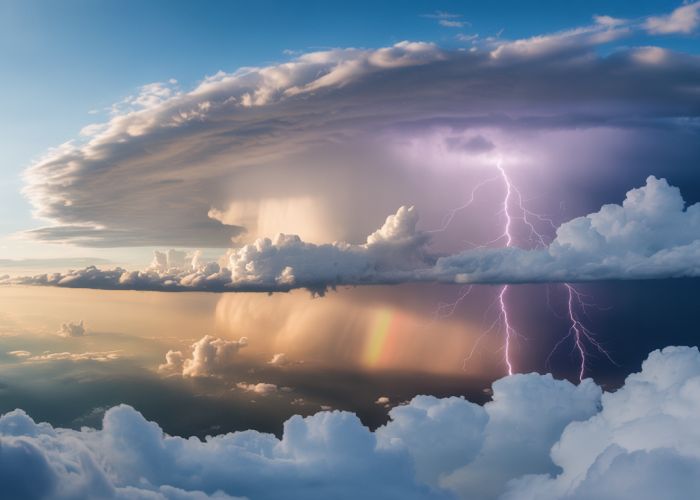The troposphere, the lowest layer of Earth’s atmosphere, is the stage for complex troposphere weather phenomena that profoundly affect daily life. The National Weather Service (NWS) meticulously tracks these events, employing sophisticated forecasting models to predict short-term and seasonal changes. Understanding how tools like the Skew-T log-P diagram reveal atmospheric stability is crucial in anticipating severe weather events. Dr. Joanne Simpson’s groundbreaking research significantly advanced our grasp of cloud physics, which is essential for explaining precipitation patterns relating to troposphere weather phenomena. By acknowledging how troposphere weather phenomena relates to the National Weather Service (NWS) and what is learned from the diagrams and figures, an understanding of these atmospheric processes are provided that can guide daily decisions.

Optimizing Article Layout: Troposphere Weather Phenomena and Their Impact
A well-structured article on "Troposphere Weather: What Phenomena Affect You Most?" centered around the main keyword "troposphere weather phenomena" requires a layout that prioritizes clarity, user engagement, and search engine optimization. Below is a suggested structure to achieve this:
Introduction: Setting the Stage
Begin with an engaging introduction that immediately clarifies the troposphere’s role in weather. Aim to capture the reader’s attention by highlighting the direct relevance of troposphere weather phenomena to their everyday lives.
- Hook: Start with a relatable scenario, e.g., "Ever wondered why some days are scorching hot while others bring torrential downpours? The answer lies in the troposphere, the lowest layer of Earth’s atmosphere where all weather occurs."
- Definition: Clearly define the troposphere and its significance in weather patterns.
- Thesis Statement: Briefly introduce the most impactful troposphere weather phenomena and their influence on daily life.
Understanding the Troposphere
This section provides essential background information for readers who might not be familiar with atmospheric science.
What is the Troposphere?
- Explain its altitude range (approximately 0-12 km above sea level).
- Describe its composition (primarily nitrogen and oxygen, plus water vapor).
- Emphasize its role as the "weather layer" of the atmosphere.
Key Characteristics of the Troposphere
- Temperature Gradient: Explain how temperature decreases with altitude. Mention the term "lapse rate."
- Air Circulation: Detail the process of convection and how it drives weather patterns.
- Water Vapor Concentration: Highlight the importance of water vapor in cloud formation and precipitation.
Major Troposphere Weather Phenomena and Their Impact
This is the core of the article, where you delve into the specific phenomena and their practical effects.
Temperature Variations
- Daily Temperature Cycles:
- Explain how solar radiation warms the Earth’s surface, leading to daily temperature fluctuations.
- Discuss factors influencing these cycles (e.g., cloud cover, latitude, season).
- Impact: Relate this to everyday choices like clothing and activity planning.
- Heatwaves:
- Definition: A prolonged period of abnormally high temperatures.
- Causes: Discuss atmospheric conditions that lead to heatwaves (e.g., stagnant air masses, high pressure systems).
- Impact: Health risks (heat stroke, dehydration), infrastructure strain (power outages), agriculture impacts (crop damage).
Precipitation
- Rainfall:
- Formation: Explain the process of cloud formation, condensation, and precipitation. Differentiate between different types of rain (e.g., drizzle, showers).
- Impact: Water supply, agriculture, flooding risks.
- Snowfall:
- Formation: Explain the process of snow formation and its dependence on temperature.
- Impact: Water supply (snowmelt), transportation disruptions, recreational opportunities.
- Hail:
- Formation: Describe the formation of hail within cumulonimbus clouds.
- Impact: Crop damage, property damage, potential injury.
Wind Patterns
- Local Winds:
- Sea breezes and land breezes: Explain how differential heating of land and water creates these local wind patterns.
- Mountain and valley breezes: Explain how temperature differences in mountainous terrain generate these winds.
- Impact: Affecting coastal temperatures, influencing pollution dispersion, affecting wind energy potential.
- Storms:
- Thunderstorms:
- Formation: Explain the conditions necessary for thunderstorm development (e.g., moisture, instability, lift).
- Impact: Heavy rain, lightning, strong winds, potential for tornadoes.
- Hurricanes/Typhoons/Cyclones:
- Formation: Briefly describe the formation process over warm ocean waters.
- Impact: Devastating winds, storm surge, flooding, widespread damage.
- Thunderstorms:
Atmospheric Pressure
- High Pressure Systems:
- Characteristics: Descending air, clear skies, stable weather.
- Impact: Generally fair weather, but can trap pollutants.
- Low Pressure Systems:
- Characteristics: Rising air, cloud formation, precipitation.
- Impact: Often associated with stormy weather.
Mitigation and Adaptation Strategies
This section can provide guidance on how to prepare for and mitigate the effects of troposphere weather phenomena.
Preparing for Extreme Weather Events
- Emergency preparedness tips (e.g., creating an emergency kit, having a communication plan).
- Home protection measures (e.g., securing outdoor furniture, trimming trees).
- Staying informed through weather forecasts and alerts.
Adapting to Changing Weather Patterns
- Water conservation measures.
- Sustainable agriculture practices.
- Building resilient infrastructure.
Troposphere Weather: Frequently Asked Questions
Here are some frequently asked questions to help you better understand the troposphere weather phenomena we discussed.
What exactly is the troposphere?
The troposphere is the lowest layer of Earth’s atmosphere, where most weather occurs. It extends from the surface up to about 7-20 kilometers (4-12 miles) high, and it’s where we live and experience all common troposphere weather phenomena.
What are the main types of troposphere weather phenomena?
Key troposphere weather phenomena include temperature changes, precipitation (rain, snow, hail), wind patterns, cloud formation, and storms (thunderstorms, hurricanes). These are all driven by solar energy and Earth’s rotation.
How does the troposphere affect our daily lives?
Troposphere weather phenomena directly influence our daily routines, from what we wear to how we travel and what activities we can do outdoors. Severe weather in the troposphere can also impact agriculture and infrastructure.
Why is understanding troposphere weather phenomena important?
Understanding troposphere weather phenomena helps us prepare for and mitigate the impacts of severe weather events. It also enables us to make informed decisions about our daily lives and contribute to climate change discussions.
So, next time you’re checking the forecast, remember all those fascinating troposphere weather phenomena swirling above! Hopefully, this article has given you a better appreciation for the science behind our everyday weather.